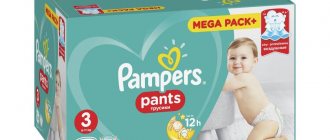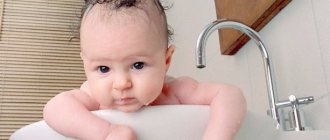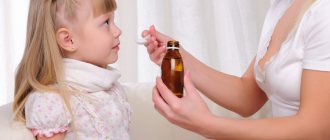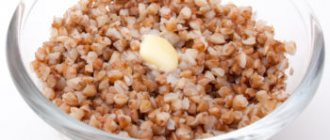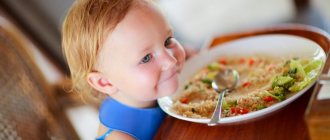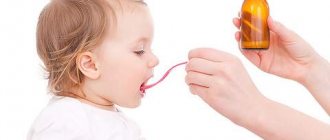Our great-grandmothers began using herbs for bathing babies, who noted their calming and disinfecting effect. Indeed, by adding herbal infusions to the bath, you don’t have to worry about tap water harming your baby’s skin. When should you start bathing your baby in herbs, how often should you do it, what mixture should you choose and how to brew the herbal decoction correctly?
I usually start bathing a newborn in herbs after the umbilical wound has healed. Chamomile and chamomile are the most “gentle” herbs; they are suitable for the first bath even for two-week-old babies, so it is better to start with them. But if a newborn has any skin diseases, then the pediatrician should advise which grass to bathe the child in.
Bathing a newborn in the infusion of the series
Series
- one of the most popular herbs for bathing newborns. It contains manganese, which has antimicrobial properties. Baths with a decoction of the string are suitable for children who have diathesis, inflammation of the skin, and seborrhea. However, the herb is considered a “skin-drying” herb, so experienced pediatricians and dermatologists advise bathing babies in this infusion no more than once a week and using baby cream after bathing.
The normal concentration for the solution is 2-3 tbsp. per liter of boiling water. The resulting decoction is added to the bath to the optimum temperature of 36 degrees.
In addition, other herbs can be combined with the string:
- Chain and chamomile, in a 1:1 ratio.
- Sequence, chamomile and sage, in a ratio of 2:1:1.
- String and mint, in a 1:1 ratio.
Such solutions relieve inflammation on the skin and calm the baby.
What herbs are strictly prohibited to use?
It is useful for young parents to know which herbs and plants contain substances that can harm the baby. They cannot be used categorically, there are good reasons for this.
A low tree or shrub related to juniper, but with a different effect. Contains mild toxins.
The plant, due to its pungent milky juice, is widely used by herbalists and healers in the treatment of skin diseases. Not suitable for children (except for severe dermatitis, but used strictly in doses and under medical supervision). Toxic, may cause poisoning.
Another name is iron ore. Contains toxins; when added to bathing water, it begins to be absorbed through the skin and acts as a poison.
Pediatricians advise against dealing with this plant because of its unpredictability. In especially small quantities it can be used to a limited extent purely for medicinal purposes; if the dosage is exceeded, it immediately becomes poisonous.
Bathing a baby in an infusion of chamomile and other herbs
Chamomile.
Very tender grass. Soothes inflamed skin, has an antiseptic and softening effect. Baths with chamomile are very useful for girls - they have a beneficial effect on the genitourinary system. Chamomile helps children with allergies well.
Birch buds, oak bark, mint
They help get rid of prickly heat and diaper rash in babies.
Lavender, hops, juniper
- the best calming herbs.
Motherwort and bearberry
will save you from colic in newborns and increased tearfulness.
The mixtures are brewed in a 1:1 ratio, 2 tablespoons of each herb per 2 liters of hot water.
Therapeutic mixtures for herbal baths
In addition to mono-compositions, there are combined collections for various purposes:
- calming;
- to relieve colic;
- to normalize tone.
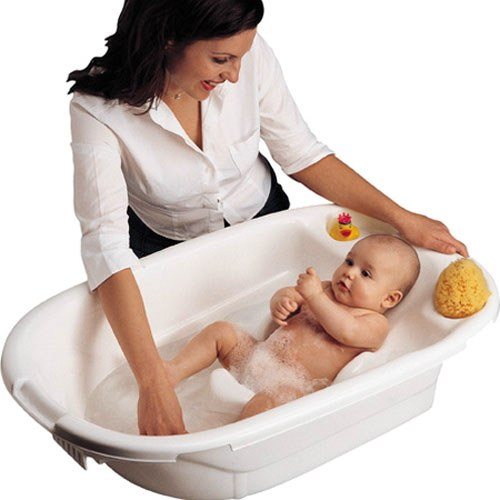
For dermatitis, rashes, as well as for their prevention, Altai herbs (the composition is called that), the collection of chamomile inflorescences, sage, flaxseed, decoctions of oak bark and birch buds help. There is no need to try all the recipes at once; you need to start with one specific one.
The calming, relaxing effect of herbs is well known. For overly nervous children, baths made from a mixture of chamomile and elderberry (flowers) will help. There is a special sedative mixture (sold in pharmacies), it is only important to adjust the dose in relation to the baby bath.
Most herbs and compositions have a complex effect, simultaneously acting as restorative, sedative and preventive (against acute respiratory infections) agents. The most common natural sedatives include valerian (root), pine needles, mint leaves, lavender, and motherwort.
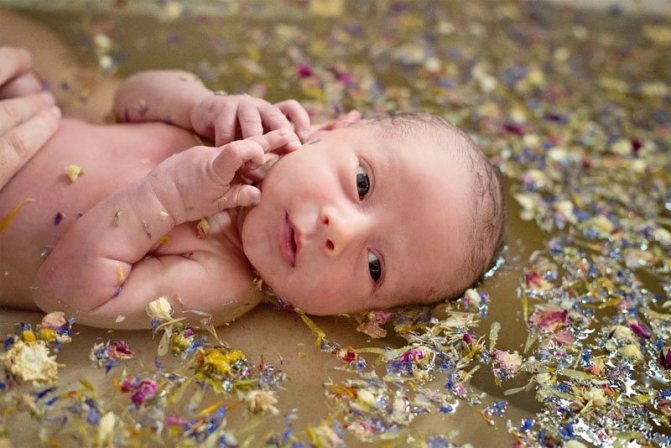
A warm bath with a temperature of 30-35 degrees has a beneficial effect on the smooth muscles of the intestines and relieves spasms in babies. If you enhance its effect with a decoction of bearberry, collecting motherwort, and hop cones, the child will calm down faster and get rid of stomach pain.
Spasmodic contractions in the muscles cause pain and prevent the baby from actively playing, sleeping or moving. To get rid of unpleasant phenomena, herbal remedies are widely used and a course of treatment is carried out (several baths).
A warm bath, taken for 10 days, with the addition of valerian, sage, motherwort, and pine needles will help the baby more calmly endure the inevitable process of changing the state of muscle fibers. And in combination with a massage, the effect will be even more significant.
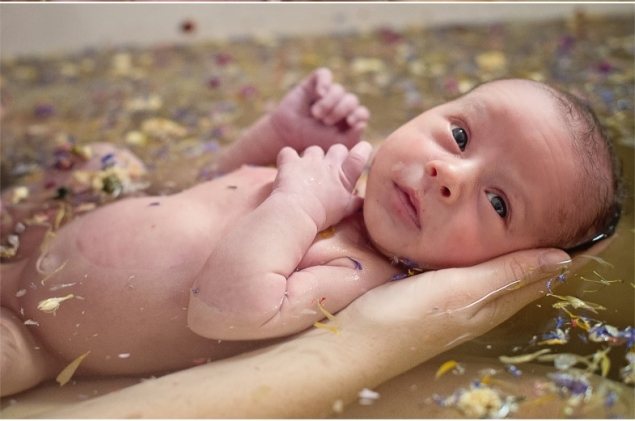
Lethargy and weak muscle tone are no less a problem than muscle spasms. And for this case there is a remedy: a combination of nettle, oregano, string, chamomile, lavender and sage. It is not recommended to use decoctions before the baby reaches the age of 4 months.
Does your baby sleep poorly, is anxious, or can’t switch gears for a long time after playing? It doesn’t matter, there are special sleepy herbs that relieve hyperactivity. Baths with infusions of valerian, lavender, chamomile, and motherwort in small concentrations will help the child relax and fall asleep quickly and soundly.
For the prevention and treatment of colds, bathing in infusions of oak bark, eucalyptus, coltsfoot, pine needles, and wild rosemary is recommended. The child will feel better, his nose will clear, and breathing will become easier. It is not recommended to perform procedures at high temperatures.
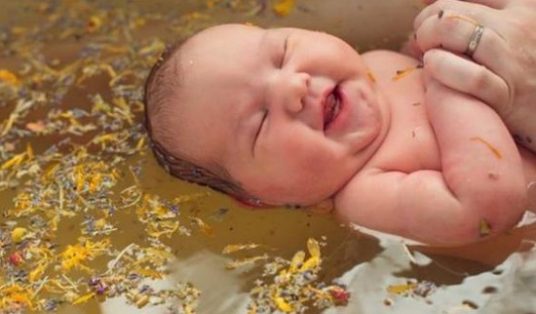
A few tips you shouldn't forget
- You should not start bathing your baby immediately in a decoction of herbal tea. Start with one herb and let your baby get used to it.
- When trying any herb for the first time, check with a drop of infusion to see if an allergic reaction will occur by placing a few drops on the child’s skin. If after half an hour there is no redness, you can safely bathe him.
- Do not experiment with mixtures, use proven recipes and consult with your pediatrician.
- The amount of weed per bath should not exceed 25 grams, otherwise an allergic reaction may occur.
- Brew the infusion an hour and a half before swimming.
- Start bathing your newborn in herbal baths from 5 minutes, increasing the time to 15 minutes. And do this 2-3 times a week, not more often, so as not to dry out the skin.
- After bathing in the herbs, it is not necessary to rinse your baby with clean water - the infusion will have its healing effect longer.
We hope that bathing in herbs will not only bring pleasure to you and your baby, but will also have a beneficial effect on the baby’s health!
Is it possible to give valerian to children: indications and risks
There are many situations in which a child may need a sedative. When the baby is excitable, exposed to stress or has problems sleeping, this is a reason to prescribe herbs. It is important to choose the right method of application and avoid side effects.
Indications of valerian for children
The advantages of using this medicinal plant are obvious: inexpensive, safe and has few contraindications.
The root contains active components that have a positive effect on the nervous system and overall well-being.
Due to its sedative effect, the use of valerian is popular for insomnia, tension, hysterical attacks, overexcitation and situations that cause severe anxiety in children.
For patients under adulthood, a neurologist can prescribe this medicine either as a single method of therapy or as a component of a complex one. Pediatricians prescribe it when a child has:
- gastrointestinal upset, poor appetite;
- overexcitement, sleep problems;
- frequent migraines.
To prescribe the drug to children under 3 years of age, indications are needed; most often it is prescribed from the age of 4. Since valerian infusion contains an alcohol component that will affect the liver, it is better to give children teas or tablets, as well as inhalations. In children 1-3 years old, the tincture often causes allergies.
In this case, instead of a calming effect, the opposite effect will appear - the child will be worried and irritated due to the itching. As a result, emotional and psychological exhaustion sets in even faster. If indications for use appear in an infant, the most correct option would be to take a drug based on valerian for the child’s mother.
After this, the baby is breastfed; through milk he will receive a small dose of the drug.
The action of valerian is primarily sedative and hypnotic. When taken, the excitability of the central nervous system decreases, it is inhibited, the heartbeat rhythm becomes smooth, blood vessels dilate, and spasms occurring in the muscles are stopped.
Valerian for children in tablets
Children three years of age and older should take the drug in this dosage form after meals with plenty of water. The dosage of valerian for children is calculated separately, it should be as follows:
| Children's age (years) | Dose of the drug (tablets 1-3 times a day) |
| 3-5 | 0,5 |
| 5-12 | 1 |
| More than 12 | 1-2 |
The instructions assume that adolescents are prescribed an adult dosage: one pill contains up to 20 mg of herbal extract. Additionally, starch, gelatin and other components are added to it. If it is known that the child is prone to allergies, the full composition of the tablets should be known before starting therapy.
Side effects and contraindications
Herbal preparations usually have few or no negative effects. But valerian has them, this is the presence of a child in the anamnesis:
- lactose or sugar deficiency, diabetes;
- poor absorption of glucose and fructose;
- allergic reactions to the drug.
Diabetes mellitus excludes taking pills, because the shell of the latter contains sugar, which is harmful.
As mentioned above, children under 3 years of age should not receive this therapy because it can be hazardous to health.
Separate mention should be made of women carrying a child - valerian is contraindicated for them during the first trimester. There is no information about how a pregnant body will take the medicine, even if it is an adult.
When for some reason an overdose occurs, this can be understood by a vivid symptomatic picture, which includes:
- nausea during the day;
- constipation or loose stool, swelling;
- abdominal pain, colitis;
- apathetic states, depression;
- inhibition of reactions;
- low emotionality or, on the contrary, a tendency to hysterics;
- constant desire to sleep;
- dilated pupils;
- allergies (skin rashes, redness, Quincke's edema);
- high blood pressure;
- lack of mood;
- tachycardia and nervous tic.
If the child has at least one of the symptoms, the medicine is immediately discontinued. To empty the stomach of it, vomiting is needed, but this is only effective if less than two hours have passed since taking the herb. You need to contact a doctor for professional help.
If this is a baby and the valerian tincture provokes side effects, call an ambulance. It is strictly prohibited for children who are intolerant to the drug. It is necessary to replace it with another, for example, bromine.
Inflammation of the kidneys, gastrointestinal pathologies and taking other sedatives are a direct contraindication.
An unreasonable increase in the duration of therapy can cause a delay in the baby’s development. This is due to the sedative effect that reduces the speed of brain activity in children taking valerian. It is advisable for parents to learn how to calm their baby without medications.
Counting on the positive effect of treatment, you need to make sure that there are no side effects of the drug. To do this, you should follow the recommendations for use and listen to the advice of your pediatrician.
And in order for the issue of using sedatives to cease to be relevant, it is necessary to regulate the child’s daily routine, establish rituals before bedtime (bathing, reading fairy tales), and also learn how to do a relaxing massage.
It is important to introduce infants into the regime from the first days, then valerian will not be needed.
Source: https://floradoc.com/stati/valeriana-detej
The most common herbs for bathing newborns
A series. The optimal herb for bathing a newborn if your baby has sensitive skin prone to irritation. They bathe in the string for diathesis, rashes, inflammations and heat rashes, as the herb is rich in antimicrobial properties.
Lavender. It is advisable to bathe in lavender before bed, because it is great for relaxing and giving strength to the baby. The pleasant aroma calms and improves well-being.
Valerian. Bathing in valerian soothes and heals wounds, strengthens the cardiovascular system.
Chamomile. The most popular herb for bathing a newborn. Chamomile soothes and has a disinfecting effect on the baby's irritated skin. Helps well with allergies.
Nettle. Softens the skin and has a general strengthening effect on the body.
Mint. Bathing in mint decoction reduces diaper rash and heat rash.
Motherwort. One of the best herbs for bathing with colic, reduces the child's increased tearfulness.
Calendula. Bathing in calendula prevents skin rashes, sores and redness. Removes inflammation, relieves itching and strengthens the skin.
Sage. Relieves irritation, redness and minor rashes, soothes and improves sleep.
Cottonweed. This herb for bathing a newborn relieves inflammation and accelerates the healing of small wounds.
Hop. An ideal herb for bathing a newborn with a restless and capricious character. Bathing relaxes, calms, relieves irritability and improves sleep.
Oregano. Essential oils contained in oregano calm the baby's nervous system and prevent skin diseases.
